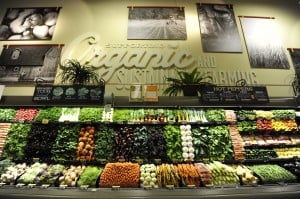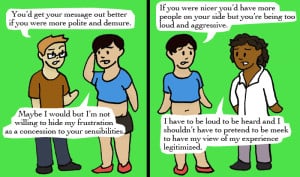
A grocery store display of vegetables under a sign reading “Organic and sustainable farming” Source: Smart Planet
As a nation, we’re slowly realizing that whole, fresh foods are good for you and that cooking at home can save you money and provide you with better nutrition.
Overall, this is a great trend. It’s becoming easier and more common to get fresh food, whole foods, local foods, and organic foods.
Unfortunately, though, this shift in culture has also begun to produce a toxic byproduct: better-than-thou attitudes and judgments about low-income people’s decisions about food.
“Why do they waste their money on junk food?” “Why doesn’t she cook for her children?” “Ugh, look, he’s buying his toddler a Happy Meal.”
Many of us have thought things like this or heard other people say things like this. We are very concerned with how poor people (or people we assume are poor) spend money on food.
The truth is, though, we rarely have all the facts when we judge these people. Let’s change that.
Why Lower-Income People Don’t Buy Fresh, Whole Food
Simply put, fast food is frequently more cost-effective for low-income people.
Elaine Livas, who runs Project SHARE, a food pantry in Carlisle, PA, says that “low-income families might know milk is better for their kids, but when it comes to filling a hungry stomach, a cheaper high-calorie option can look pretty good.”
Furthermore, low-income people may not have storage for fresh food or appropriate or adequate facilities to prepare it.
Brooke McLay wrote about taking a homeless woman shopping and the food choices she made. The woman, Tori*, a mom of two young girls, explained “I’m in Crisis Housing, so no lock or key for our stuff. Everything we own is in the wagon; it has to go everywhere with us or it gets stolen.”
Getting to grocery stores, even, can be a challenge. Many low-income workers have more than one job or work a job with hours that make getting to a grocery store when it’s open impossible. Without a car, low-income families rely on buses, which may not serve the areas they live or may be unreliable.
Sometimes grocery shopping itself is simply indecipherable. People living in poverty may have not had access to nutrition or grocery shopping education.
If you lack food literacy, or general literacy, grocery shopping can seem like an insurmountable task. Especially if you need to make price comparisons or read the ingredients on packaged food, low literacy is a serious barrier.
We don’t even make nutrition information easily accessible to educated people, let alone people who have been denied educational opportunities.
And low-income people know they’re getting judged for their choices.
Tori clearly wants to make sure McLay knows about the obstacles she faces when buying food for her girls: “Here’s the thing,” she explained. “We can’t have anything perishable in the shelter. So, the girls never get enough fruits or vegetables. We don’t have a stove or a fridge. I don’t want you to think I’m buying bad things. I just don’t have a way to keep the good things.”
Why What We’re Doing Isn’t Helping
Even organizations designed to help frequently get it wrong. I worked for an anti-hunger organization whose pricing was so out of touch that I — while employed by them — was unable to afford to make their recipes regularly.
In fact, I decided to do a challenge where I ate only their recipes for a week. These recipes were marketed to low-income families as cost effective ways to eat healthier. A week’s worth of groceries (for two people) for this challenge cost $150. My partner and I had previously been spending about $25 a week because that’s what we could afford.
Furthermore, the recipes required a blender, freezer space, and so on — items that people without stable housing or who can’t afford kitchen gadgets wouldn’t be able to access.
It’s very comforting to think we’ll be able to solve America’s nutrition crisis by building more grocery stores in low-income neighborhoods and educating low-income families on how to cook healthy, nutritious meals.
But the unfortunate truth is that more grocery stores and nutrition education (while helpful to some people) doesn’t address the larger problem — which is that eating is expensive.
According to the Population Reference Bureau, the number of low-income families is increasing. The report defines low-income working families as “those earning less than twice the federal poverty line.”
In 2011, the low-income threshold for a family of four with two children was $45,622. If you estimate rent at $1000/month, which is quite low for a family of four, that leaves about $33,000 for health care, transportation costs, clothing, and groceries for four people. That’s $687.50 per person per month for every single expense except rent.
Let’s do some more math.
Bartlett Pears are among the cheapest fruit nationally. The USDA lists them at $1.55 a pound at the time I’m writing this article. There are about three pears to a pound, so if you wanted to buy your two kids an pear for each day of the week, you would spend $7.23 just on an afternoon snack for your kids. And let’s keep in mind that pears are relatively low-calorie, which means they aren’t very filling.
Seven bucks doesn’t seem like much to someone with a middle class salary, but when you’re working with a weekly budget of under $700 per week for everything you need, including car repairs, gas money, winter clothing for constantly growing children, toilet paper, laundry detergent, electric bills… $7.23 starts to look pretty hefty for a snack that won’t even satisfy.
“I look at this list and can’t help but wonder how she’s supposed to do it. If $11 of apples equals two snacks, but $3 in Ramen will feed her entire family for dinner, how can she possibly pick apples with her limited food stamp budget?”McClay wonders.“And how will she ever afford to fill half of every mealtime plate with fruits and veggies, the amount recommended by the same government that issued her food stamps?”
It’s a good question.
The US government heavily subsidizes some foods, such as corn and soybeans. The result is that processed foods that are heavy in these ingredients end up being cheaper than fresh produce, which is not as heavily subsidized, if it is at all.
There is a serious disconnect between what we should be eating to stay healthy, and what the economic reality is.
What We Can Do to Help
Anti-hunger organizations who offer cooking, shopping, and nutrition information are helping. Food pantries are helping, and community gardens are helping.
But none of these are permanent measures. They are all band-aids over a much deeper wound.
Food policy in this country heavily favors nutritionally lacking food. To really address the cause of widespread hunger and food-related diseases, we need better policy.
The Food Trust is on the right track. They’re tackling hunger and lack of access to healthy food on a variety of fronts. They are advocating for the national Healthy Food Financing Initiative, a partnership between the US Departments of Treasury, Agriculture, and Health to encourage fresh food retail development across the country. They’re educating policymakers on the SNAP-Ed program.
Best of all, they’re convening a regional Farm Bill working group to advocate for the Greater Philadelphia region — a crucial step in fixing the broken agricultural system that rewards quantity and not quality.
PolicyLink (a national research and action institute dedicated to advancing economic and social equity) and The Reinvestment Fund (an institution that finances neighborhood revitalization projects) are also throwing their weight behind policy change.
If you want to help, read up on the farm bill. Support politicians who stand up to the powerful agricultural lobby to try to chip away at the monopoly unhealthy food hold on our market.
Donate to organizations like those mentioned above — not just organizations that feed people, but organizations who are trying to level the playing field. The goal is for food banks to be for emergencies, not a way of life.
*Name has been changed.
[do_widget id=”text-101″]
Wiley Reading is a Contributing Writer at Everyday Feminism. Wiley is a New Jersey-born artist, writer, environmentalist, and social justice advocate located in Burlington, VT. He works as a community health worker for the Greater Burlington YMCA, and writes for Disrupting Dinner Parties, a small collective feminist blog. In his free time, Wiley draws bugs and old buildings, loves every show on the Food Network, makes creative (read: pulled from the recycling) toys for his bunnies, and tipsily reminds every person in every bar that New Jersey is the best state. Follow him on Twitter @wreadinggo.
Search our 3000+ articles!
Read our articles about:
Our online racial justice training
Used by hundreds of universities, non-profits, and businesses.
Click to learn more




















